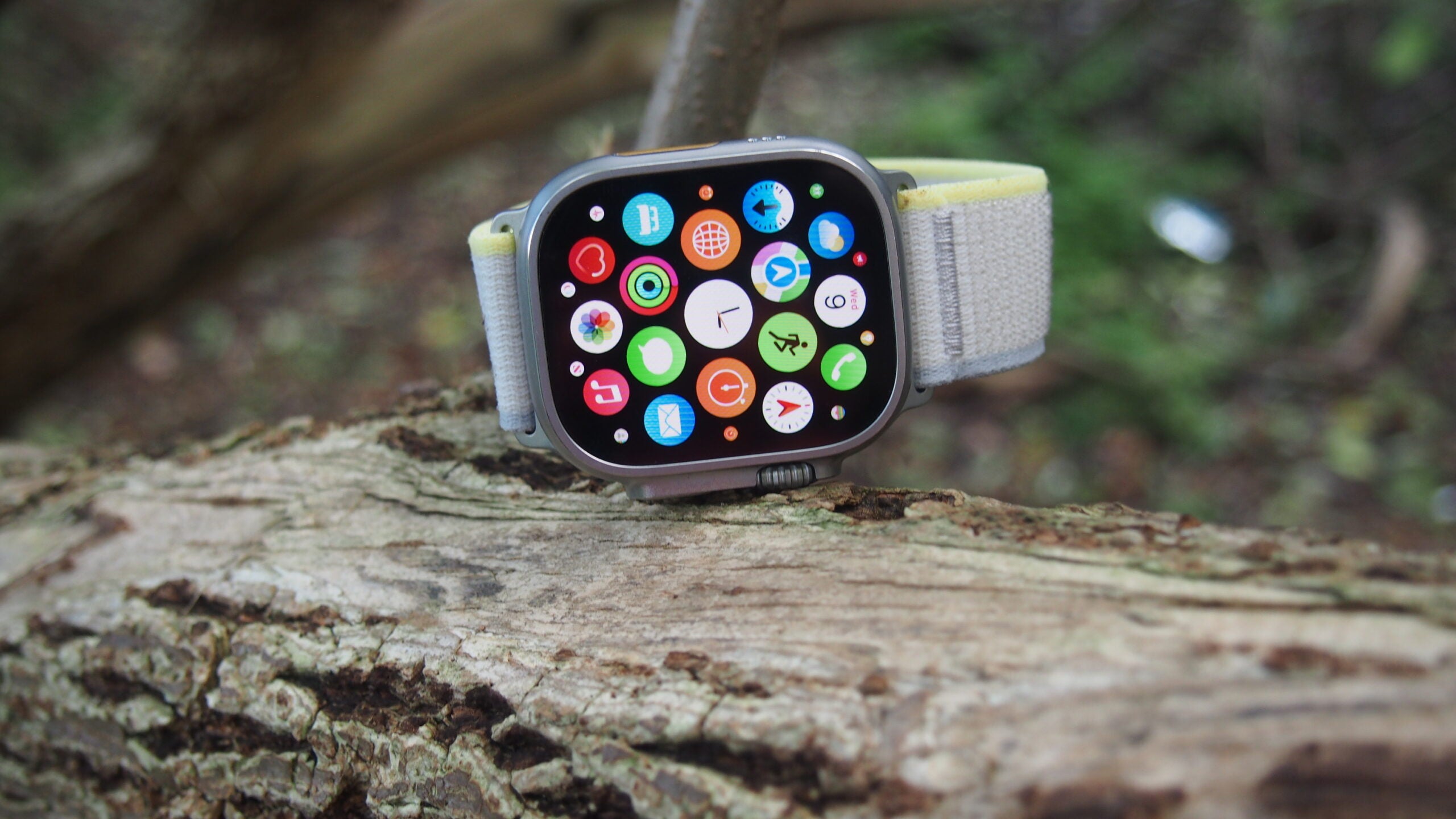Verdict
The Apple Watch Ultra is a great smartwatch that takes everything you get from the Series 8 and gives it a design and feature set update and greater battery life to make it a much better companion on hikes and long runs as well as for more extreme use in the watery depths.
Pros
- Improved battery on previous Apple Watches
- Surprisingly light design
- Good sports tracking performance
- Bigger, brighter Retina display
Cons
- It’s not cheap
- Design could be sleeker
- Some outdoor features are a work in progress
- New straps are a mixed bag
Availability
- UKRRP: £849
- USARRP: $799
- EuropeRRP: €999
- CanadaRRP: CA$1099
- AustraliaRRP: AU$1299
Introduction
The Apple Watch Ultra is a smartwatch that Apple hopes will appeal to adventurers, explorers, endurance athletes and to anyone who loves the Apple Watch but wishes it was better suited to more rugged use.
Sitting above the new Apple Watch Series 8 and Apple Watch SE, the Ultra delivers the biggest display on an Apple Watch and a design that you can go diving with. It also has the kind of battery life that should make it fit to last a very long run, bike ride, hike or walk.
That new design and more outdoor-friendly features come at a pretty steep price, however, with the Ultra costing twice as much as the Series 8. So does Apple deliver the goods to justify that price jump?
Design and Screen
- 49mm case
- New physical Action button
- 100m water resistance rating
Design-wise, the Ultra still channels that Apple Watch look the world is already very familiar with. But here, Apple has given it a bigger case and a new set of strap options and bolstered things in the physical controls department.
You’ve now got a 49mm case, which is a big jump from the 41mm and 45mm options of Series 8. There’s a titanium case as opposed to the choice of aluminium or stainless steel you get on Apple’s cheaper watches. Meanwhile, the removable watch strap is actually compatible with straps that work with the 45mm and 44mm Apple Watches.
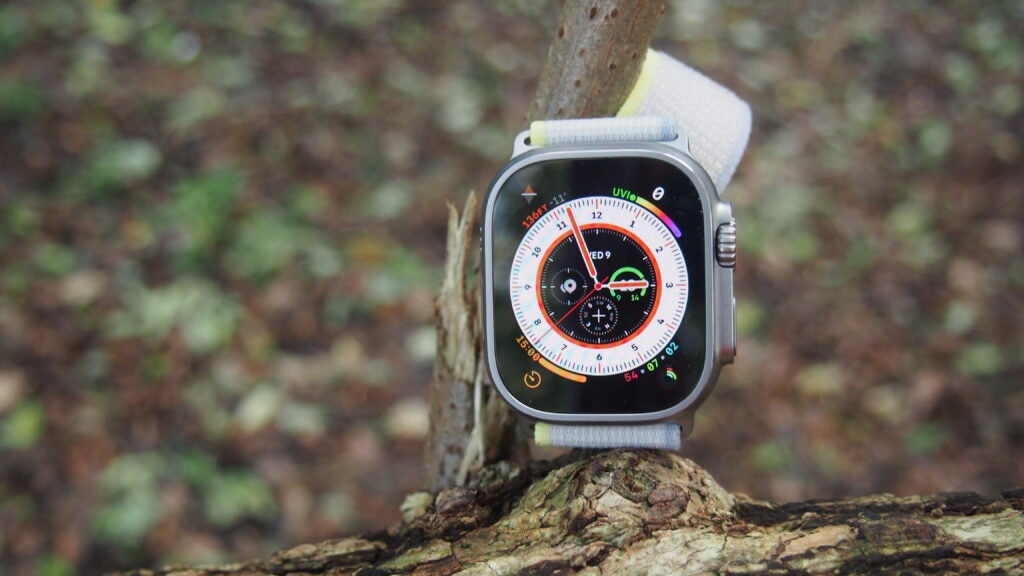
That said, it’s a significantly bigger watch to live with. If you really liked the smaller size of previous watches, you might have a harder time getting on with just how much bigger the Ultra is.
Thankfully, that extra bulk doesn’t mean it’s heavy: the Ultra weighs 61.3g, which is about double the weight of regular Apple Watches. I wore it for a marathon, long swims and hikes, and that additional weight wasn’t a major issue for me. The move to titanium seems to have done the trick – it’s a strong metal that will still keep down the overall weight.
What that larger case also gets you is a bigger display. It’s an always-on Retina one, so it matches the display tech found on the Series 8, but you’re getting a superior 410×502-pixel resolution and more screen estate to play with. I
t’s not just the bump up in resolution that’s a big deal here. You’re getting a screen that offers a maximum brightness of 2,000 nits, which is a major help in terms of providing the kind of visibility you’ll need in intense outdoor light. This isn’t a display that struggles in typically challenging outdoor conditions.
If you look around the screen, you’ll notice that the case surrounding it has a different feel to the Apple Watches you know. There’s that side button and larger watch crown, but it sits further away from the case. On the left-hand side, you have the dual speaker set-up, with the primary one on top designed to give call quality a boost and the one further down being a new siren speaker, which, in an emergency, can emit a siren sound that can be heard from 600ft. I can confirm it’s loud.
The big addition here is the Action button – the first new physical button Apple has introduced in its Watch series. This button is orange to make it more visible, according to Apple, and can be assigned features like quickly starting a workout, accessing the new Compass app, turning on the flashlight and launching the new Backtrack navigation features. While it’s great to have another physical button, making the Ultra feel more like other outdoor watches, it can be rather easy to press accidentally, which can be a nuisance at times. Thankfully, you can disable it in the Watch settings on your iPhone, but it’s possibly a bit too sensitive if you do want to have it activated.
Unlike its other watches, Apple has sought to make the Ultra a more rugged affair. It has done that by getting the watch tested to military-grade MIL-STD-810H standard, to better protect it against shock and use in high and low temperatures, high altitudes and freezing conditions. This watch has a stronger water resistance certification that makes it suitable for being submerged in water to a maximum of 100m. There’s also the added EN13319 certification, making it safe for recreational diving to a maximum of 40m.
There are other new elements in the design, such as better protection around the display edges and, also, the use of sapphire-front crystal to guard against scratches. While the Ultra doesn’t look like a watch that’s built for rugged use, I didn’t see any worrying signs of wear or damage in my few months of testing it.
Lastly, let’s get into the business of straps. Apple has become renowned for making very good straps for its smartwatches. For the Ultra, the brand sought to make a new set that complements the ways in which the watch can be put to tougher use. The orange Alpine Loop strap seems to be aimed at hikers. The nylon Trail Loop is the lightest strap, built for runners and endurance athletes, while the Ocean Band – surprise, surprise – is designed for use in the water.
For something that Apple has done such a great job with, I can’t help thinking these new straps aren’t the best ones I’ve used on an Apple Watch. The Trail Loop doesn’t feel like the nicest nylon strap, and the Alpine loop also has an odd feel to it. I ended up using the Ocean Band the most, as it offered a reliable fit – although it does feature quite an odd clasp set-up.
The key takeaway from the Apple Watch Ultra is that it’s bigger but doesn’t weigh heavy on the wrist. You get a lovely, big and bright display and an extra button that’s a welcome but far from a revolutionary addition in sports watch terms. You’re getting a mixed bag with the straps too, but largely, the design works. It just needs some refining in places.
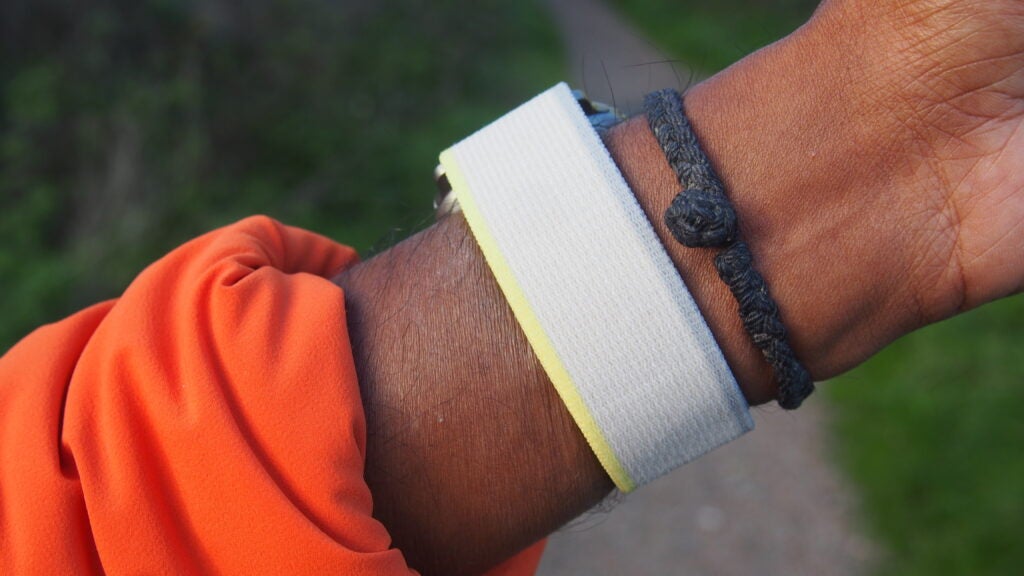
Features and performance
- Runs on Apple S8 64-bit, dual-core processor
- 32GB storage
- LTE capable
- Apple Pay and App Store access
The Apple Watch Ultra, like the Series 8 and SE watches, runs on the same dual-core S8 processor and also includes the same W3 and U1 chips as the Series 8.
Apple’s latest version of watchOS is in place, so you can expect a software experience that feels familiar and also has that customary zip we’ve come to know on Apple’s smartwatches. Swiping through screens, opening apps, getting apps onto the watch – it’s all very slick business on the Ultra.
The same companion apps are needed on your iPhone: the main Watch one and the Fitness app to check in on your tracking stats. If you make use of Apple Health, it will of course work with that as well.
The experience of using the Ultra as a smartwatch feels as good as it does using other Apple Watches – it’s the best out there in terms of intuitiveness, ease of setting it all up and quickly getting to know what this wearable is capable of.
Features, such as viewing and handling notifications, using Apple Pay, and tapping into music support for services like Apple Music and Spotify, feel effortless to use and work really well. There’s Siri, if you want it to send messages or make queries via voice commands, and LTE connectivity is standard too. Apple’s packed on three microphones and that bigger primary speaker, so it’s well equipped to handle voice control and offer a louder speaker set-up when you need to deal with calls on the move.
You still have arguably the best app ecosystem in place to bolster just what the Ultra is capable of. The experience of searching and downloading apps directly from the watch feels nicer to do on that bigger screen as well. Of course, doing this on your phone is even easier, but ultimately, apps are in place and ready to use in a quick fashion.
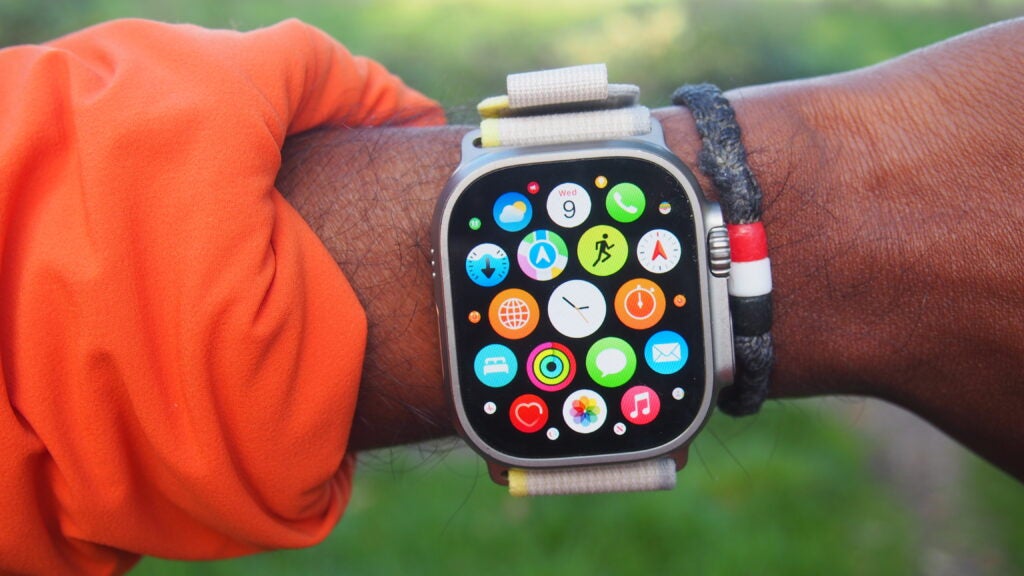
Fitness and health tracking
- Dual-frequency GPS
- Improved Compass app and Backtrack mode
- ECG and blood oxygen sensors
- Water temperature sensor
Now, I’ll get into the nitty-gritty of why the Apple Watch Ultra exists, which is mainly for people who like the Apple Watch but want it to better handle more extreme exercise and activity time.
For runners, the big feature here you don’t get on other Apple Watches is dual-frequency GPS, which will also appeal to cyclists. It works via L1 and L5 frequency GPS bands, along with Apple’s new custom algorithms, to deliver more precise positioning data in areas where accuracy can be challenging – think densely wooded areas or a city with tall buildings. Fortunately, I had the opportunity to test this out at the Chicago Marathon, which is renowned for some of the most challenging GPS tracking conditions due to the number of tall buildings.
I put it to the test against the very accurate multiband mode on the Garmin Epix 2 and compared it with data from my timing chip. While the Ultra’s tracking performance wasn’t spotless, it actually handled those conditions more reliably than the Garmin watch. In a shorter 10k race in Loch Ness, the Ultra matched the Epix for data. Despite the odd bit of pacing data, I’d say this is one of the best-performing GPS watches I’ve tested.
Away from running, you have features built for hikers, too – namely the new Compass app and Backtrack mode that can be accessed from the new Action button. With the Compass app, you have the option of three views, mixing digital and analogue displays to help you get a better idea of your surroundings. There’s an orienteering view, where you can see any set compass waypoints that can be done from the Action button. It’s also where you’ll find the Backtrack feature, which allows you to retrace your steps to your starting point – as long as you set up the precise location tracking mode on the watch first.
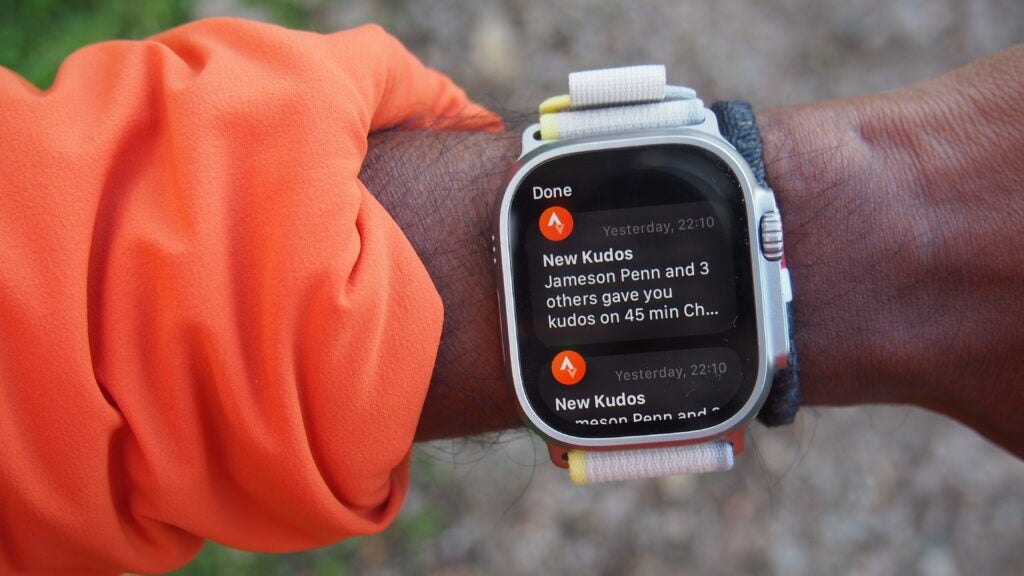
The hiking experience is good but by no means perfect, and this is definitely an area where the Ultra could improve. Using the Compass app is fine for understanding whether you’re headed in the right direction, but it really needs some rich mapping to go with it to give you a sense of what’s around you. The only way to get that type of mapping in this mode is by using a third-party app instead. Apps like Komoot and WorkOutDoors can give you that, but you’ll need to pay for them. It’s a similar story with the navigation features: it’s great to have Backtrack, but you can get a better navigation experience with watches that cost less than the Ultra.
Another important feature for the Ultra is the fact that it’s suitable for diving and the kind of watersports that previous Apple Watches simply weren’t been built for. Along with the improved protection and durability for activities like kitesurfing and wakeboarding, the Ultra can also behave as a dive computer. It includes a depth gauge and water temperature sensor. A new Depth app springs into action when the watch is submerged to a depth of 1m or more. The watch can send out alerts about water depth and low battery, while the new Oceanic+ app turns it into a dive computer and also allows you to plan future recreational dives.
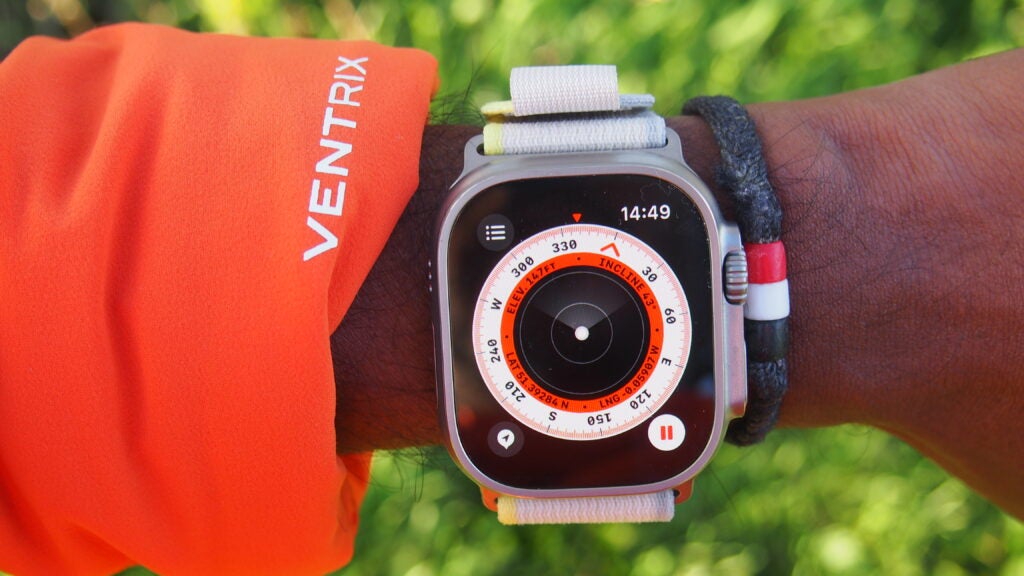
Outside of those features aimed at runners, explorers and divers, pretty much everything you get on the Series 8 is here as well: the new crash detection mode, ECG app, blood oxygen tracking, and the same great activity tracking with some slowly improving native sleep-tracking support. However, the Ultra is a noticeably bigger watch to take to bed. You still get optical heart rate monitoring, but unlike Apple’s other recent watches, based on my testing, it’s a bit more susceptible to delivering unusually high maximum heart rate readings during exercise, when compared with a chest strap monitor.
There’s certainly more good than not-so-good here. Apple has areas to work on to make this a better outdoor smartwatch, but the core sports and fitness tracking experience is very strong and gives the brand something to build on. I hope the improvements will take the form of future watchOS software updates rather than having to wait for new hardware.
Battery life
- Up to 36 hours in normal use
- Up to 60 hours with low power settings
- Charges fully in 1.5 hours
The Apple Watch Ultra lasts longer than previous Apple Watches, and that’s a fact. Whether you set that screen to always-on or not, this watch can last a couple of days even with some of the more power-hungry features in use.
To push things a bit further, Apple also includes additional low power settings, one of which will help make sure you get to the end of the day by turning off features like irregular heart rate notifications and the always-on display mode. The other is an arguably more useful low power mode, which gives you 60 hours of normal use. But that mode will reduce the sampling of heart rate and GPS data during workout tracking.
But I can confirm that the Ultra performs well in that tracking mode. It comfortably lasted a three-hour-and-30-minute marathon, dropping just under 20% when used in the most precise GPS mode and with heart rate monitoring enabled.
The charging set-up hasn’t changed: Apple uses the same style cradle as with smaller watches, with a USB-C fast-charging magnetic cable letting an hour-long charge get you from zero to 80% and a 1.5-hour charge getting you from zero to 100%.
Latest deals
Should you buy it?
If you want an Apple Watch with a bigger screen and longer battery life: The Ultra lasts longer than previous Apple Watches even when it’s put to more extreme use, and it has a bigger, brighter screen to boot.
You want the best outdoor watch available: While Apple’s first effort at extreme sports is a good one, Garmin reigns supreme for features like mapping and navigation, if that’s something you’re looking for in an outdoor watch.
Final Thoughts
The Apple Watch Ultra might not be the perfect smartwatch for adventurers and endurance sports lovers just yet, but it will work better for serious runners and water sports lovers than any other Apple Watch models.
Apple’s watchOS software remains slick, sports tracking is solid overall – with arguably the best smartwatch app ecosystem to fill in the gaps in the experience. Plus, you’ve got more battery life to play with: this watch will last a marathon with battery to spare.
How we test
We thoroughly test every fitness tracker we review. We use industry standard testing to compare features properly and we use the watch as our main device over the review period. We’ll always tell you what we find and we never, ever, accept money to review a product.
FAQs
The Apple Watch Ultra carries a WR100 water resistance rating and an EN13319 certification, helping to make it suitable for recreational diving to a maximum of 40m.
Yes, you can pair external heart rate monitors with the Apple Watch Ultra as Health Devices in the Bluetooth settings on the Watch.
Jargon buster
GPS
An abbreviation of the Global Positioning System, which uses satellite communication to pinpoint your location. Some smartwatches are able to achieve this communication without the use of a smartphone.



















